Article and all photos by Joe Mock, BaseballParks.com
All rights reserved
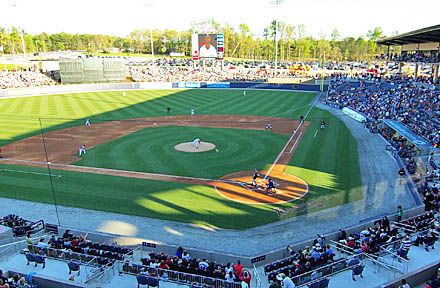 |
There are a lot of descriptions you can hang on Gwinnett Stadium. Ambitious. Striking. Innovative. Friendly. And definitely hastily built.
| Ballpark Stats |
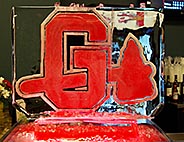 |
| Team: The Gwinnett Braves of the Triple-A International League |
| First game: April 17, 2009, a 7-4 loss to Norfolk |
| Capacity: 10,427, of which 7,777 are fixed seats |
| Architect: HKS |
| Construction: Barton Malow |
| Price: $59 million for the actual construction, plus $5 million for the acquisition of the land |
| Home dugout: Third base side |
| Field points: East by southeast |
| Playing surface: natural grass |
| Betcha didn’t know: The outfield dimensions match Turner Field’s |
It’s been years since a ballpark — especially one at the Triple-A level — was designed and constructed as quickly as Gwinnett Stadium, which is just outside of Atlanta. Imagine this timeline: in January, 2008, the Atlanta Braves announced they were moving their top farm team (they own the franchise) from Richmond to Gwinnett County, Georgia for 2009. The next week, HKS was officially named the architect to design the new park. Ground was broken on the site on June 3. And 800,000 man-hours of construction (one can only imagine how much of it was overtime) later, it opened April 17, 2009, with the park’s very first pitch shown in the photo above. Wow! Normally, stadium design and construction feel like a marathon. In this case, it was more like a mad dash.
Now, I know what you’re thinking. Since this was done in such a hurry, the design of the park must not be very nice and the construction probably is on the slipshod side.
You’d be wrong.
The design from HKS Architects has some very clever elements, and Barton Malow’s construction is top notch. Is the park perfect? No. I have some gripes about some of the park’s idiosyncrasies, but they might’ve been done the same way if the design team had been given all the time in the world.
So how did a Triple-A franchise wind up in the suburbs of Atlanta? “A ballpark wasn’t even on the radar screen until two years ago,” Preston Williams told me about two hours before the facility’s first pitch. Williams is the Managing Director of the Gwinnett Convention and Visitors Bureau. “One of the County Commissioners who is a huge baseball fan brought it up at a County retreat. He wanted to see if minor-league baseball could make a go of it in Gwinnett County.”
Because Williams’ organization had done a stellar job bringing a first-class arena to the area, they were brought in to conduct a feasibility study in 2007. That study indicated that the County was “as strong a community to support baseball as anywhere in the country on all of the measurements that they looked at,” he reported. The nearby big-league Braves weren’t in favor of such an encroachment of their territorial rights, so Gwinnett started examining independent-league franchises, as these wouldn’t require the approval of the Braves.
Two developments changed the Braves thinking. First, they finally got around to reading that feasibility study, “and it really impressed them,” said Williams. “Plus, the Braves were facing serious issues in Richmond. (They) invited me to a meeting at the team offices. They said that they didn’t have any confidence that a (new) park was going to happen in Richmond.” So the big-league team decided to conduct its own research to determine if having a Triple-A team in the Atlanta market would hurt the attendance at Turner Field.
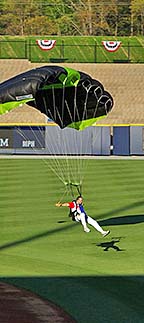 |
“They found there was no negative impact,” Williams said. And with that, the Braves duplicated the path that they’d followed with their Double-A franchise when they pulled out of Greenville, South Carolina (which dragged its feet on approving a new ballpark) and moved into a shiny new facility in Pearl, Mississippi.
So exactly how did the design and construction come about so quickly? “We didn’t have time to go the traditional route (of first completing the design of a park and then starting construction), so we used ‘design build.’ We had to,” Williams said. The County Board of Commissioners selected a proposal by HKS, partly because they’d been working with the Braves on a possible new park in Richmond, and partly because they “brought to the table a team concept that would work for a schedule-driven project like this.”
So HKS, Barton Malow, the County and the Braves started to hammer out how the ballpark would happen in less than 15 months from the date the Braves made it official that they’d be bringing their top minor-league team to Georgia. “It was pretty crazy,” said Fred Ortiz, senior designer at HKS, as they all knew that construction would commence before many of the final design decisions had been made. That’s how it works in a “design build” process, and thankfully the meetings of the parties showed remarkable harmony. “When everyone got together at the table,” said HKS’s Mike Drye, “if we’d had arguments, the ballpark never would’ve gotten finished (in time).”
Indeed, it was completed when it needed to be — just in time for a parachutist to rush in with the first-pitch baseball. Something about the speed of that struck me as pleasingly appropriate!
So how did the quickly constructed ballpark turn out? Let’s take a closer look at its location, its exterior, its interior design and how well it serves the fans of Gwinnett County.
The Setting
The new park is located in a (for now) fairly undeveloped area on Buford Drive north of Lawrenceville, about a mile south of I-85. The massive Mall of Georgia is on the north side of the intersection of Buford and the Interstate, in case you want to do some shopping before heading to a G-Braves game.
It would’ve been spectacular if the stadium had been constructed in the Gwinnett Center, where the County’s Convention Center, Performing Arts Center and Arena all share the same parking. These facilities, by the way, are all positively gorgeous, with acres of parking and fairly easy access to I-85.
Alas, with the topography of the land and the space that had already been developed with office buildings, there wasn’t a spot to locate the new ballpark.
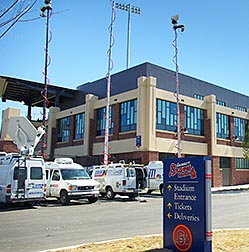 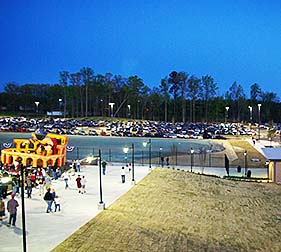 |
So the planners looked seven miles farther east on the Interstate. They found a 40-acre parcel that would be perfect to act as an entertainment hub for County residents, and purchased 12.3 acres of it for $5 million. “The rest of (the parcel) is for hotel, retail and restaurants,” Williams said.
But as the park opened, none of this other development was anywhere to be found. In this regard, Gwinnett’s new park is in exactly the same boat as the new facilities in Goodyear, Glendale, Ft. Wayne and Reno, all new parks for 2009 that have incredibly ambitious plans for commercial and residential development surrounding them, but not a bit of it is completed when the parks opened their doors. Indeed, in the shot on the right above, note the graded area beyond the kids zone in right field. It’s just waiting for commercial buildings to be constructed.
The way Gwinnett Stadium and the parking are situated makes for a less-than-optimal east-by-southeast orientation of the ballpark (the official baseball rule book strongly suggests an east-by-northeast orientation). The parking, though, is done very logically, as three main entry points exist — one on each side of the park on Buford Drive, and another from the north on Tech Center Parkway. This will help traffic flow when all of the retail and residential development is done as well.
One thing that isn’t helped is the awful traffic that exists on I-85 heading northeast out of Atlanta in the early evening of weekdays, when a lot of home games will be played. Head to the park early!
The Exterior
So what greets you when you arrive at the park? Well, it’s not the drop-dead gorgeous exterior of the new park in Columbus, Ohio or the incredible color scheme at the Reno Aces’ new stadium (these are the other two Triple-A parks to open in 2009). It is, however, very nice in its use of masonry materials and a striking entry area behind home plate.
 |
Because the parcel of land is anything but flat, the main exterior of the park behind the infield has an unusual uphill feel as you head toward the main entryway from either side. It’s well balanced, though, and uses a nice mixture of concrete, brick and glass. To break the monotony, different hues were used for the glass, similarly to the light-hearted windows at Isotopes Park in Albuquerque.
A lot of thought went into the entry plaza behind home plate (below left). The ticket windows and dedication plaques are all here, as well as nice touches like the masonry “pitcher’s mound” (below right). There’s also a large roof to keep the hot Georgia sun off of patrons waiting to meet their friends there. The entryway’s roof, it was pointed out to me by my good ballpark friend Graham Knight, does have a bit of a bus-station look, but it is compatible with the overhang structures inside.
 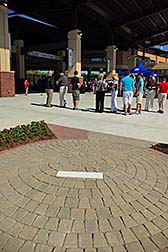 |
And it’s the roof that is one of the ballpark’s most noteworthy features, in that it overlaps in a novel way behind home plate. Unfortunately, you can’t really observe this very well from the outside — or from the seats, unless you are really looking for it. You can see it clearly if you happen to be in a helicopter above the facility. Well, at least you can see it from somewhere, because it’s a nice change from the typical look.
Maybe this is partly intentional. “I like not giving it all away” when you’re looking at the park from the outside, noted HKS’s Ortiz. “You see the park’s beautiful look (fully) when you go inside.”
The exterior of the outfield is really just a chain-link fence for now (below, obviously taken long after the game was over). This will undoubtedly change significantly as commercial buildings rise around the park, particularly beyond left field, where a row of bars and restaurants is planned.
As is the case with Goodyear, I’m really looking forward to coming back here in a couple of years when the surrounding development has been completed. I bet I won’t recognize the place.
 |
The Design
Despite being in a huge hurry, HKS was able to do some research in preparing to design Gwinnett Stadium. They studied noteworthy baseball stadiums in Georgia’s past for signature features like rooflines and nearby structures. And they also drew inspiration from a building in Gwinnett County. “If you like Gwinnett Center, then you’ll really like this,” said Williams, referring to the nearby arena that is consistently voted one of the top minor-league-hockey and concert venues in the land. “HKS really looked at our arena, and some of the feel was employed here.”
Williams also pointed out that the Atlanta Braves were quite influential in the stadium’s design. They wanted their minor leaguers to feel at home here — and to feel comfortable when they move up a notch to Turner Field. That’s understandable, but that also creates a series of problems that hamper an important part of Gwinnett Stadium — its outfield.
 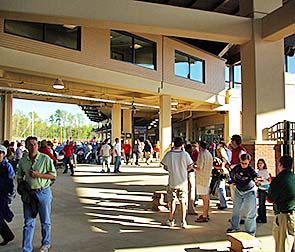 |
But we’ll come back to that in a moment. Let’s first look at what most fans will see when they enter the park: the infield concourse and seating bowl. In fact, the fans entering the park on the left above are seeing the place for the first time, as this is the initial opening of the gates prior to the park’s first game.
The good news is that the concourse and seating sections work well. They are a little unconventional, but it allows fans to move around and watch the game comfortably — and that’s the most important thing.
The concourse itself is quite wide behind home plate, but shrinks to a smaller size as you head toward the outfield on both sides. This created a bottleneck on opening night, but there were probably a lot more fans than normal wandering around, taking it all in. Happily, that concourse is fully open to the field all the way around from foul pole to foul pole, unlike the other two Triple-A parks opening this year (Columbus and Reno).
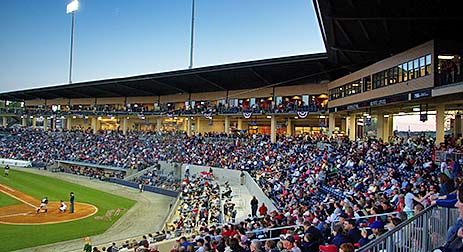 |
As the shot above shows, the seating bowl has a little bit of Citizens Bank Park-feel, with the backstop being made up of straight, rather than curved, lines. And the well-heeled fans are well taken care of, as the Home Plate Club sections directly behind that backstop commandeer quite a few rows between the dugouts.
The upper deck, with its large lounge, pressbox and 22 luxury suites, is very well done. At least the pressbox is where it should be, behind home plate, rather than all the way down the first-base line like in Reno.
If you’ve read a lot of my in-depth reviews, you know I’m a fan of 360-degree concourses, and Gwinnett Stadium certainly has one (unlike Columbus). Most certainly, this allows you to walk all the way around the field, taking in the view from lots of different vantage points. You might not always like what you see, though.
That’s because, in my opinion, the outfield didn’t turn out nearly as well as the rest of the ballpark. I’m not holding the architects or the breakneck “design-build” process responsible for this. The more I think about it, the biggest problem is that the Braves wanted the same rounded outfield fences and dimensions as Turner Field. What works well in Atlanta’s big-league park simply doesn’t in a minor-league facility.
 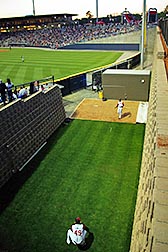 |
One problem is the way the bullpens are arranged. In Atlanta, there is enough room for them to be perpendicular to the outfield walls. In Gwinnett County, that wasn’t feasible. Since bullpens, by their very nature, are straight and not curved, this made both the home and visitor bullpens extend into the outfield berm in positively bizarre angles, as the shots above attest.
But there’s another aspect to the outfield that troubles me even more: the sightlines from the berms. I can only describe them as awful.
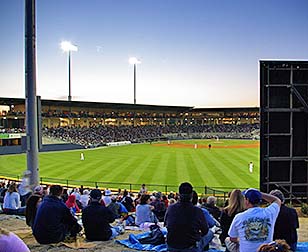  |
If you have general admission tickets and you want to sit on the berm, please do yourself a favor and arrive early to claim a spot in right field. If you end up in right center or left center, your view of the action will be what you see above. The batter’s eye, plus the huge poles supporting the lights, will make seeing the playing field a challenge.
Admittedly, this is also the case in San Diego’s Petco Park. There, though, they installed a beautiful, color video screen on the back of the batter’s eye to allow folks in the “Park at the Park” area beyond right field to see what’s happening if there’s a play in left. At Gwinnett Stadium, you won’t know what happened in real time. You’ll have to hope for a replay on the scoreboard behind you. Honestly, I can’t believe that the batter’s eye had to be done like this. There is a tremendous amount of dead space behind the batter’s eye. It could’ve been moved up the hill, away from the center-field fence, and roped-off grass or some kind of dark vegetation could have occupied the area beyond the fence. Hey, in both Reno and Columbus, the batter’s eye doesn’t impede the view of the field for any fan on the berms.
While I’m picking on the outfield, there’s also a retaining wall beyond the left-field fence that I don’t understand at all. It’s not aesthetically pleasing in the least, and I can only surmise it’s necessary to help support a commercial building that will be constructed up on the concourse level at some point.
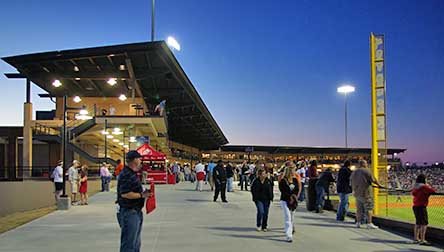 |
Finally, I’m a lot more bullish on the roof — or maybe I should say roofs, since the one over the first-base-side structure is separate and distinct from the one on the third-base side. The roof arrangement is one of the ballpark’s more novel features, especially the way it overlaps behind home plate — as you can see somewhat in the shot above. Most ballpark overhangs are curved. Not here! There are strictly straight edges happening here, and these still allow about 30% of the seats in the main bowl to be under cover.
And I think it’s also praiseworthy that Gwinnett Stadium doesn’t look like HKS’s other ballparks. “HKS has done a lot of minor league ballparks,” noted Ortiz, among them Round Rock, Corpus Christi, Frisco and North Little Rock — all positively outstanding facilities in my estimation, and all are quite different from each other. “HKS prides itself on being innovative. We ask ourselves what we can do differently” for each new baseball project.
So there is some solid, innovative design work in Gwinnett Stadium, especially in the infield. The outfield, though, leaves something to be desired. Again, I think this is largely due to the Braves’ insistence on perfectly round outfield fences, rather than architectural mistakes by the design-build team.